Antibody data
- Antibody Data
- Antigen structure
- References [2]
- Comments [0]
- Validations
- Immunocytochemistry [3]
- Immunohistochemistry [1]
- Other assay [4]
Submit
Validation data
Reference
Comment
Report error
- Product number
- PA5-30327 - Provider product page

- Provider
- Invitrogen Antibodies
- Product name
- PUM1 Polyclonal Antibody
- Antibody type
- Polyclonal
- Antigen
- Recombinant full-length protein
- Description
- Recommended positive controls: 293T, A431, Jurkat, Raji, mouse brain. Predicted reactivity: Mouse (100%), Rat (100%), Zebrafish (93%), Xenopus laevis (97%), Chicken (98%), Bovine (99%). Store product as a concentrated solution. Centrifuge briefly prior to opening the vial.
- Reactivity
- Human, Mouse
- Host
- Rabbit
- Isotype
- IgG
- Vial size
- 100 μL
- Concentration
- 1.49 mg/mL
- Storage
- Store at 4°C short term. For long term storage, store at -20°C, avoiding freeze/thaw cycles.
Submitted references PUM1 Is Overexpressed in Colon Cancer Cells With Acquired Resistance to Cetuximab.
RNase L promotes the formation of unique ribonucleoprotein granules distinct from stress granules.
Liu Q, Xin C, Chen Y, Yang J, Chen Y, Zhang W, Ye L
Frontiers in cell and developmental biology 2021;9:696558
Frontiers in cell and developmental biology 2021;9:696558
RNase L promotes the formation of unique ribonucleoprotein granules distinct from stress granules.
Burke JM, Lester ET, Tauber D, Parker R
The Journal of biological chemistry 2020 Feb 7;295(6):1426-1438
The Journal of biological chemistry 2020 Feb 7;295(6):1426-1438
No comments: Submit comment
Supportive validation
- Submitted by
- Invitrogen Antibodies (provider)
- Main image
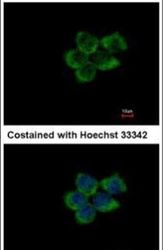
- Experimental details
- Immunofluorescent analysis of Pumilio 1 in methanol-fixed A431 cells using a Pumilio 1 polyclonal antibody (Product # PA5-30327) at a 1:500 dilution.
- Submitted by
- Invitrogen Antibodies (provider)
- Main image
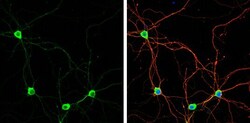
- Experimental details
- Immunocytochemistry-Immunofluorescence analysis of PUM1 was performed in DIV9 rat E18 primary hippocampal neuron cells fixed in 4% paraformaldehyde at RT for 15 min. Green: PUM1 Polyclonal Antibody (Product # PA5-30327) diluted at 1:500. Red: beta Tubulin 3/ Tuj1, stained by beta Tubulin 3/ Tuj1 antibody. Blue: Fluoroshield with DAPI.
- Submitted by
- Invitrogen Antibodies (provider)
- Main image
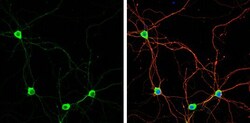
- Experimental details
- Immunocytochemistry-Immunofluorescence analysis of PUM1 was performed in DIV9 rat E18 primary hippocampal neuron cells fixed in 4% paraformaldehyde at RT for 15 min. Green: PUM1 Polyclonal Antibody (Product # PA5-30327) diluted at 1:500. Red: beta Tubulin 3/ Tuj1, stained by beta Tubulin 3/ Tuj1 antibody. Blue: Fluoroshield with DAPI.
Supportive validation
- Submitted by
- Invitrogen Antibodies (provider)
- Main image
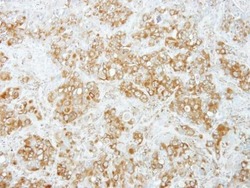
- Experimental details
- Immunohistochemical analysis of paraffin-embedded H441 xenograft, using Pumilio 1 (Product # PA5-30327) antibody at 1:100 dilution. Antigen Retrieval: EDTA based buffer, pH 8.0, 15 min.
Supportive validation
- Submitted by
- Invitrogen Antibodies (provider)
- Main image
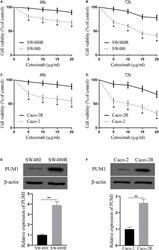
- Experimental details
- FIGURE 1 Pumilio RNA-binding family member 1 (PUM1) is upregulated in cetuximab-resistant colon cancer cells. SW480 and SW480R cells were incubated with cetuximab for (A) 48 h and (B) 72 h, and cell proliferation was determined using the Cell Counting Kit-8 (CCK-8) assay. Caco-2 and Caco-2R cells were incubated with cetuximab for (C) 48 h and (D) 72 h, and cell proliferation was determined using the CCK-8 assay. (E,F) Western blot analysis of PUM1 levels in colon cancer cells. beta-actin served as a loading control. Data were presented as mean +- SD of three independent experiments. * p < 0.05, ** p < 0.01.
- Submitted by
- Invitrogen Antibodies (provider)
- Main image
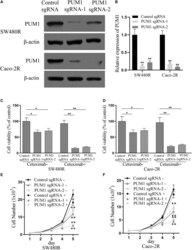
- Experimental details
- FIGURE 2 Suppression of pumilio RNA-binding family member 1 (PUM1) inhibits proliferation of cetuximab-resistant colon cancer cells. (A,B) Western blotting assay for the levels of PUM1 in SW480R and Caco-2 colon cancer cells. beta-actin served as a loading control. (C) SW480R and (D) Caco-2R cells were incubated with or without cetuximab for 72 h, and cell proliferation was determined using the Cell Counting Kit-8 (CCK-8) assay. (E) SW480R and (F) Caco-2R cells were grown in six-well plates, and the cell number was determined. Cetuximab+ and cetuximab- represent the culture media with and without 10 mug/ml cetuximab, respectively. Data were presented as mean +- SD of three independent experiments. * p < 0.05; ** p < 0.01.
- Submitted by
- Invitrogen Antibodies (provider)
- Main image
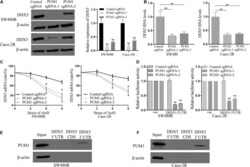
- Experimental details
- FIGURE 3 Pumilio RNA-binding family member 1 (PUM1) positively regulates DEAD-box helicase 5 (DDX5) mRNA expression through DDX5 3' untranslated region (UTR). (A) Western blotting analysis of DDX5 proteins in both PUM1-deleted SW480R and Caco-2R cells. (B) beta-actin was used as a loading control. Relative quantities of DDX5 mRNAs, extracted from sgRNA-control and PUM1-KO cells, were estimated using qRT-PCR. (C) Glyceraldehyde 3-phosphate dehydrogenase (GAPDH) serves as a control. The mRNA decay rate of DDX5 as indicated in SW480R and Caco-2R cells by qRT-PCR after suppressing PUM1 expression followed by actinomycin D treatment (10 mg/ml) for specified time points. (D) GAPDH serves as a control. Dual-luciferase assays showing the luciferase of DDX5 3' UTR following PUM1-KO. The empty 3' UTR luciferase plasmid served as a loading control. Synthetic RNA oligos with the indicated PUM1 consensus sequences for DDX5 were examined through RNA pull-down and blotted for PUM1 in (E) SW480R and (F) Caco-2R cells. Data are mean +- SD of three independent experiments, and each was measured in triplicate. * p < 0.05, ** p < 0.01.
- Submitted by
- Invitrogen Antibodies (provider)
- Main image

- Experimental details
- FIGURE 5 DEAD-box helicase 5 (DDX5) is critical for pumilio RNA-binding family member 1 (PUM1)-mediated cetuximab resistance. Western blotting assay for the levels of PUM1 in (A) SW480R and (B) Caco-2 colon cancer cells. beta-actin served as a loading control. (C) SW480R and (D) Caco-2R cells were incubated with or without cetuximab for 72 h, and cell viability was determined using the Cell Counting Kit-8 (CCK-8) assay. (E) SW480R and (F) Caco-2R cells were grown in six-well plates, and the cell number was determined. Data were presented as mean +- SD of three independent experiments. ** p < 0.01.
 Explore
Explore Validate
Validate Learn
Learn Western blot
Western blot Immunocytochemistry
Immunocytochemistry